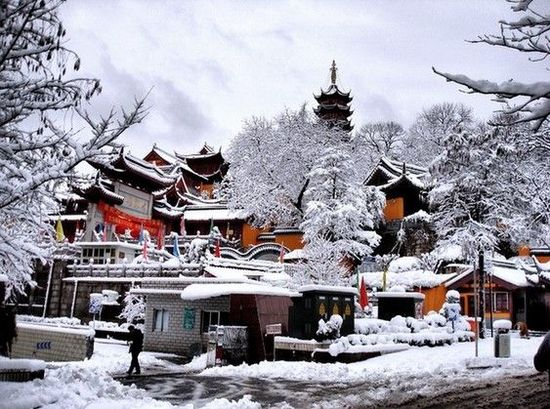Serene place of learning stood strong during tumultuous times

Today Jiming Temple is hidden in the downtown area of Nanjing, but its charm is timeless.
Every city has its best vantage point for enjoying the scenery. In Nanjing, this is Huomeng Pavilion, located inside Jiming Temple. Famous Chinese economist and historian Zhu Xie (1907-68) once wrote: “When I reached the top of Huomeng Pavilion and looked around, overlapping and magnificent mountains came before my eyes. Fuzhou Mountain, Tianbao Fortress and Zijin Mountain are spread out and surrounded with white clouds. A beautiful lake lies north of Huomeng Pavilion; glittering green and blue colors in the sun. Mountains, water, willows and cattails play off each other beautifully. This is the real joy of enjoying this beauty.” Besides the beautiful mountains and lake, Huomeng Pavilion has witnessed many changes in modern Chinese history.
The establishment of Huomeng Pavilion was proposed by Zhang Zhidong (1837-1909), a representative of the Westernization Movement in the late Qing Dynasty and the governor of Liang Jiang, which today encompasses an area including Shanghai as well as Jiangsu, Anhui and Jiangxi provinces. But why did Zhang want to establish Huomeng Pavilion in Jiming Temple? Liu Chengyu (1876-1953), a modern bourgeois revolutionist, revealed the truth in his memoirs: The establishment of Huomeng Pavilion was to honor Yang Rui, one of the Six Gentlemen of the Hundred Days’ Reform in the late Qing Dynasty, who was executed in the Caishikou area of Beijing. Yang was Zhang’s best student when Zhang served as Sichuan provincial education commissioner. And later Yang became Zhang’s assistant and many of Zhang’s petitions to the throne were written by Yang. When Zhang was transferred to become the head of the Hu Guang area, which today includes Hubei and Hunan provinces, he built up the Hubei-Hunan Academy of Classical Learning. At that time, Yang took the responsibility of teaching history courses.
In 1894, the year when the First Sino-Japanese War (1894-95) broke out, Zhang served as the governor of Liang Jiang. One day, Yang accompanied Zhang to visit Taicheng, the old palace of the Eastern Jin Dynasty (317-420) and Southern dynasties (420-589) in Nanjing, and lived in Jiming Temple at night. Under the moonlight, they drank, talked and forgot the time and place. The location where they spoke freely is today’s Huomeng Pavilion. But when they quoted the classics and history that night, they didn’t aim to show off their knowledge. In fact, they borrowed those quotations to express their concern about the changing situation in modern China.
In Zhang’s eyes, the only way to save modern China from feudal ignorance was “Chinese knowledge as the core and Western knowledge as the supplement.” Zhang devoted himself to learning Western knowledge and promoted cultural education, built industries, made firearms and trained armies. However, he could not save China by simply borrowing Western knowledge. People’s narrow-mindedness and decadent ideas were already everywhere. One vivid example of this was when a successor turned Huomeng Pavilion into a retreat for entertaining bureaucrats.
The Revolution of 1911, led by Sun Yat-sen, overthrew the Qing Dynasty (1616-1911), and Huomeng Pavilion became a place for scholars to read. On Dec. 13, 1937, Nanjing was occupied by Japanese and more than 300,000 innocent Chinese people were murdered in the Nanjing Massacre. Beijige near Huomeng Pavilion was the site of ruthless murders, so who would be in the mood to visit Huomeng Pavilion at that time?
After the War of Resistance against Japan, Huomeng Pavilion gradually returned to peace. In 1983, Huomeng Pavilion was restored and basically returned to the scale it enjoyed in the late Qing Dynasty.
LINK
The Jiming Temple was established in the Western Jin Dynasty (265-317) and is one of the oldest Buddhist temples in Nanjing. It is known as the first temple of the Southern dynasties, or the peak of the Southern dynasties’ 480 temples. During the Southern Dynasties, Jiming Temple was the center of Chinese Buddhism.
